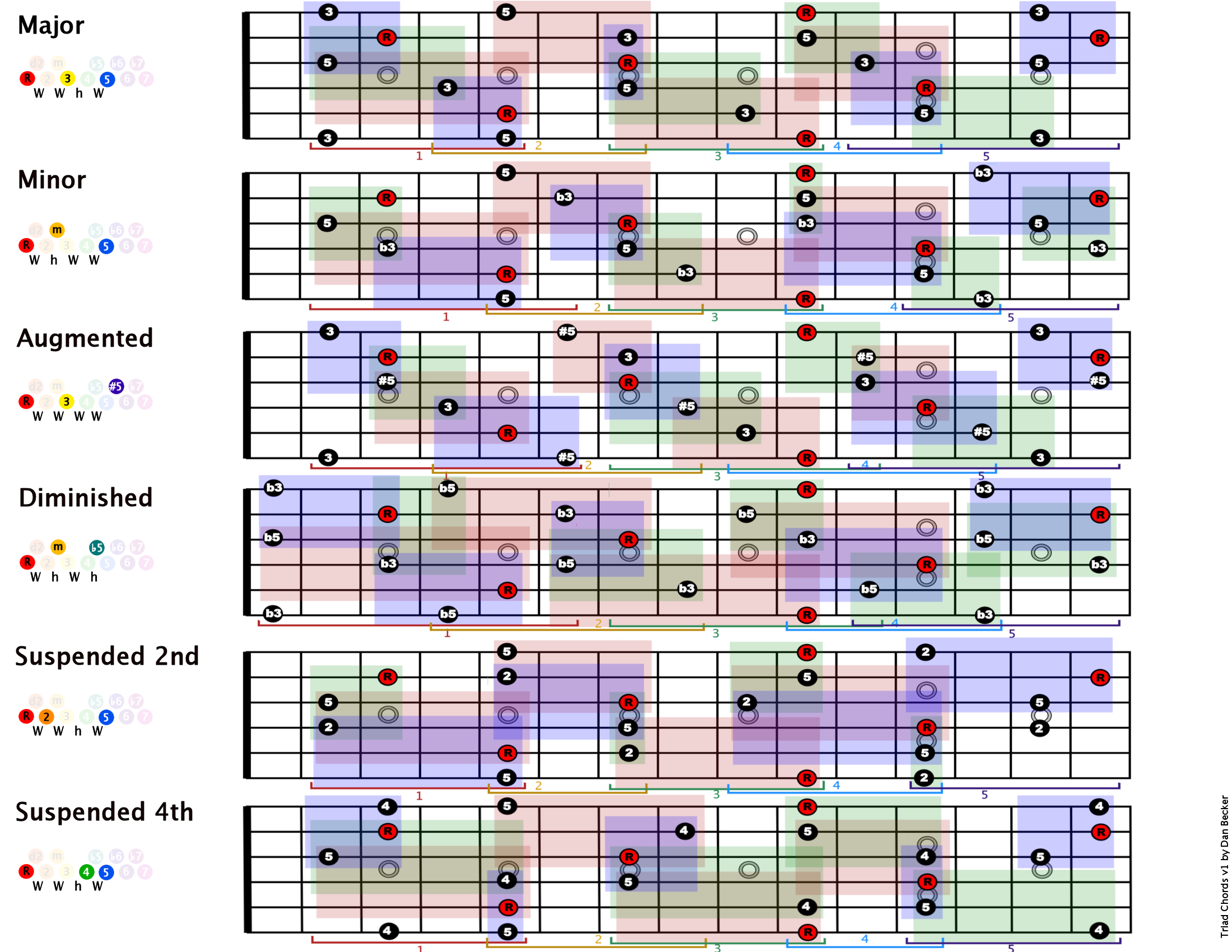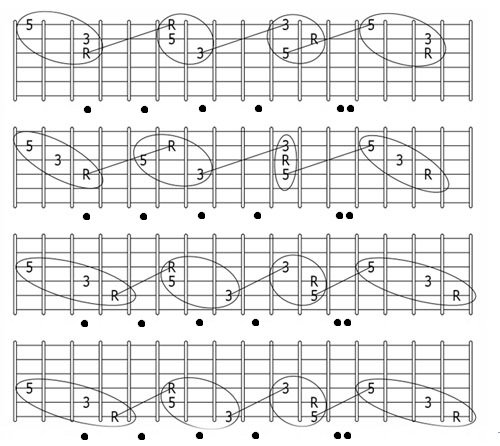eBook
I am planning on self-publishing the largest book of guitar chords
ever made. I hope it will become an important chord encyclopedia for
learning chords for the dedicated musician.
Inspiration for this work came from several chord bookswhich
I found in this order:
-
Picture Chord Encyclopedia
by Hal Leonard Corp
-
Chord Chemistryby Ted
Greene
-
The Guitar Grimoire: Chord Encyclopedia by Adam
Kadmon
- Fretboard
Chord Charts by Tony Pappas
Currently I have around 6000 chords, with around 50% of it being in the key
of E and A. I am currently deciding if I should balance out the data so
that each key will have an equal number of chords, or if I should instead
pick a key such as E or A, and create the shapes around one root
note.
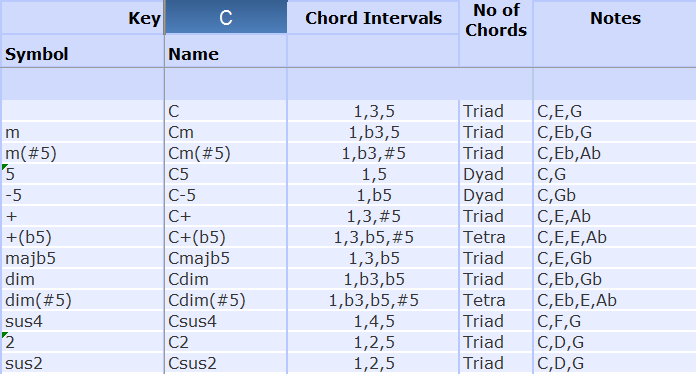 I envisage around 130-200 chord types
eg major, minor, sus2, sus4, diminished, half-diminished etc. I hope that
for each chord type there will be around 10-20 different voicings of each
chord including usually 3 or 4 inversions, so we are looking at 130
x 20 x 4 = 10,400 chords fingerings.
I envisage around 130-200 chord types
eg major, minor, sus2, sus4, diminished, half-diminished etc. I hope that
for each chord type there will be around 10-20 different voicings of each
chord including usually 3 or 4 inversions, so we are looking at 130
x 20 x 4 = 10,400 chords fingerings.
I also have other data on chords which I would like to augment the database
with so that users can indentify drop 2, drop 3, drop 4, slash chords,
block chords, sheering style chords etc. I hope to also apply Ted Greene's
way of organising 4-note chords into his V-System to help the advanced
guitarists with finding the right voicing for their harmonic situation.
While Ted Greene's book contains a wealth of knowledge and wisdom, it is
very poorly organised. The book is very amature with a cheap publishing
feel as here are some hand-writen chord names and the fretboard dots are
also hand-drawn. The organisation feels haphazard and it is not organised
in a way that is searchable as a dictionary.
The challenge in organising a good chord dictionary will be to find a
balance between keeping the chord database lean and providing the right
kind of visual representation. The majority of chord books, for example
Chord Encyclopedia and Chord
Chemistry, show a chord diagram with 5 frets layed out vertially and a
start fret indicated for navigation at the top of the diagram. While it is
an efficient use of space it doesn't give you the bigger picture that a
diagram with 12 or more frets may show.
Sample pages from the books listed above.
It was refreshing to see
Guitar Grimoire Chord Encyclopedia by Adam Kadmon stray from convention
and explore larger fretboard views with 15 frets showing per diagram, so
that all 12 keys could be shown for a chord side by side. The small
downside is that each chord takes up half a page because the chord is shown
seperately for 12 keys and also makes it difficult or impossible to
annotate the note names. Another book which uses a larger fretboard section
with 19 frets is Fretboard
Chord Charts by Tony Pappas who lays them out horizontally, as I am
planning to.
When I created my sample view with 20 chord voicings all in different
colours on one fretboard diagram it looked like a young child had attacked
a music book with marker pens. I knew right away, there had to be a cleaner
way to do this. When I saw that Tony Pappas had solved this problem
beautifully, I wondered why I hadn't thought it. What is ingenious about
his method is that he places all the inversions on the same fretboard
diagram which means there are minimal overlaps of shapes. This makes
printing easy, and the page is visually very pleasing to look at. Tony
Pappas also used the idea I had of showing ghost notes, so that you can
make small alterations to the chord if you feel the need to try something
different. Ted Greene also had notation for optional notes, but the hand
writing sometimes made it difficult to understand.
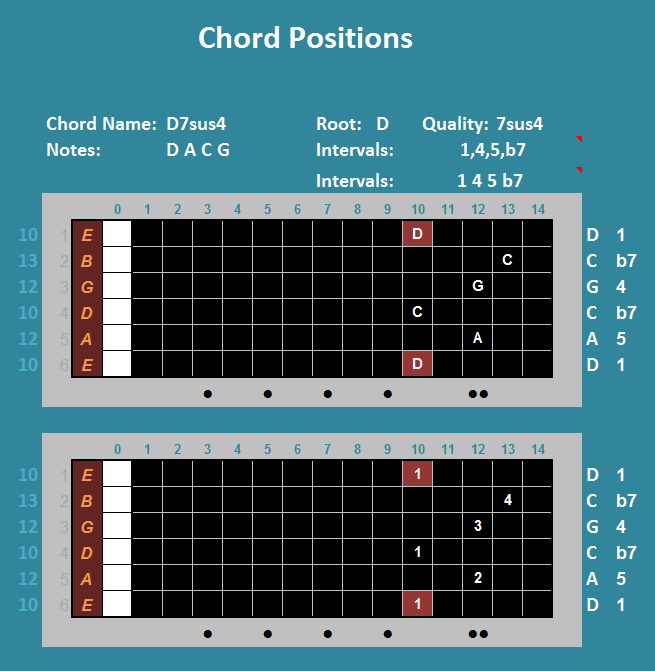 In the Guitar
Grimoire, before going into the 12 keys there is a closeup view of the open
chord fingering, the moveable chord fingering and the intervals of the
notes. Adam Kadmon's book doesn't have the note names under the strings,
however there is staff notation under each chord for those than can read
it. In constrast The Picture Chord Encyclopedia incorporates note names and
staff notation wonderfully for novice musician and sight readers. If
you only put one chord per diagram, you're able to add notes and intervals
next to each string, however efficient use of space is somewhat reduced. In
theory you could add in ghost note markers for root notes and other
intervals in a lighter colour to increase the usefullness of non-fingered
area.
In the Guitar
Grimoire, before going into the 12 keys there is a closeup view of the open
chord fingering, the moveable chord fingering and the intervals of the
notes. Adam Kadmon's book doesn't have the note names under the strings,
however there is staff notation under each chord for those than can read
it. In constrast The Picture Chord Encyclopedia incorporates note names and
staff notation wonderfully for novice musician and sight readers. If
you only put one chord per diagram, you're able to add notes and intervals
next to each string, however efficient use of space is somewhat reduced. In
theory you could add in ghost note markers for root notes and other
intervals in a lighter colour to increase the usefullness of non-fingered
area.
One of the challenges of creating a layout for all the information is
finding the right compromise as there is a lot of data that is needed to
explain the intervals of the chord, the note names and fingering as well as
staff notation. Having a set key approach like Tony Pappas simplifies
things greatly and allows you to compare different voicings to the root
note on different strings as well as reinforce octave root positions. While
Pappas' approach is visually stunning and easy to understand those who want
to understand the interval structure and staff notation of a chord may feel
something is missing. On the down side to a set-note chord book, if you
want a chord in a particular key you will have to transpose it
yourself.
One novel approach of showing complex groupings of chords is to use
tranlucent colours for shapes. To automate the graphics you could use
overlapping boxes for the inversions, as in this example in the left table.
As a side note I think that half-step notation is less useful in the same
way that roman numerals are less than useful for mathematical operations
such as addition. For instance, Major triads shown with whole steps and
half steps W-W-h-W could simply be shown as 2+2+1+2. In this way, you can
instantly calculate how many semitones you are away from the root at every
interval. I think after a while you would quickly learn the semi-tone
distances for each interval simply by seeing how the chord is constructed
with the addition of distances between notes.
On the right we have a less busy fretboard layout with no overlapping
shapes, with the Major triad showing and all their inversions. As you can
see, one needs to weigh carefully the amount of information conveyed
against what you can process quickly.
What I have been thinking about is if there is a way to organise groups of
chords in a compact way, that looks good, is easy for a computer to
generate, and conveys important and clear information at once. Here is an
example of indicating diatonic 7th chords with the root notes on the low E
string. As the notes do not overlap, you could easily add intervals to each
note of the chords as well.

Having now collected all these ways of seeing chords on the fretboard
its
time to put them to the test with the chord database I have been
building. There are quite a few more steps to make before I can start
with publishing, including verifying the data, which involes working in
Excel and Python. I've been working with someone on a chord fingering
engine to automatically suggest fingerings for new chords as I have
previously been working with a variety of people to manually enter
chords and their fingerings for me. I may be starting on a new project
to also generate new possibilities for chord voicings that I don't
already have, which should be exciting.
In
terms of a table of contents, I almost have the structure down for the
sequence of chord types - I think its looking pretty good as I'm
sorting it by several columns in Excel, including by chord count. For
additional information on the page I'm considering alternative ways of
highlighting groups of chords in terms of rhythem chords, melody
chords, muted strings or Ted Greene four-chord voicings. I'm also doing
music theory research to aid my understanding of chord structure and
seeing how I can convey other important information in diagrams. There
is a lot of musical information to be integrated into music pedagogy
that I feel is not being taught and to find the best methods, you have
to dig deep and investigate. For example, how many of you have heard of
the circle of thirds and how this can help you read staff notation on the treble, bass, alto and tenor clef?
Stay tuned for future progress reports!
 I envisage around 130-200 chord types
eg major, minor, sus2, sus4, diminished, half-diminished etc. I hope that
for each chord type there will be around 10-20 different voicings of each
chord including usually 3 or 4 inversions, so we are looking at 130
x 20 x 4 = 10,400 chords fingerings.
I envisage around 130-200 chord types
eg major, minor, sus2, sus4, diminished, half-diminished etc. I hope that
for each chord type there will be around 10-20 different voicings of each
chord including usually 3 or 4 inversions, so we are looking at 130
x 20 x 4 = 10,400 chords fingerings. 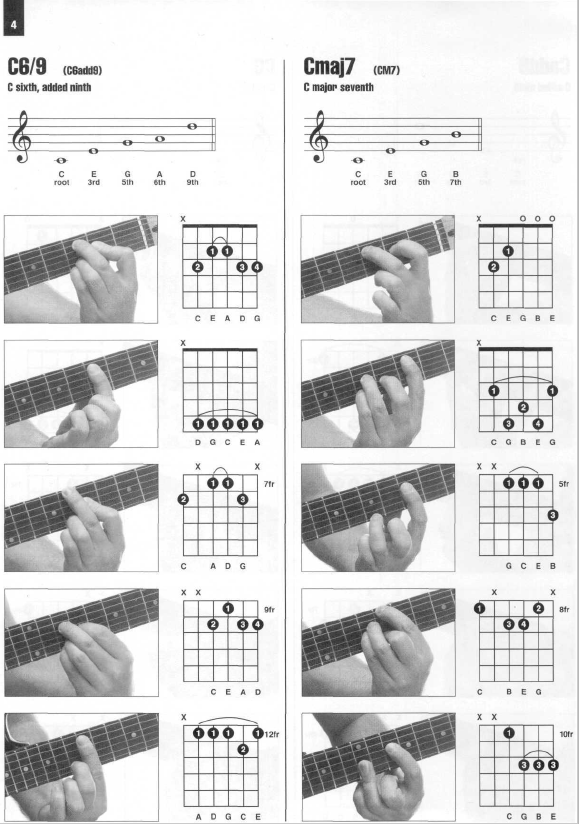
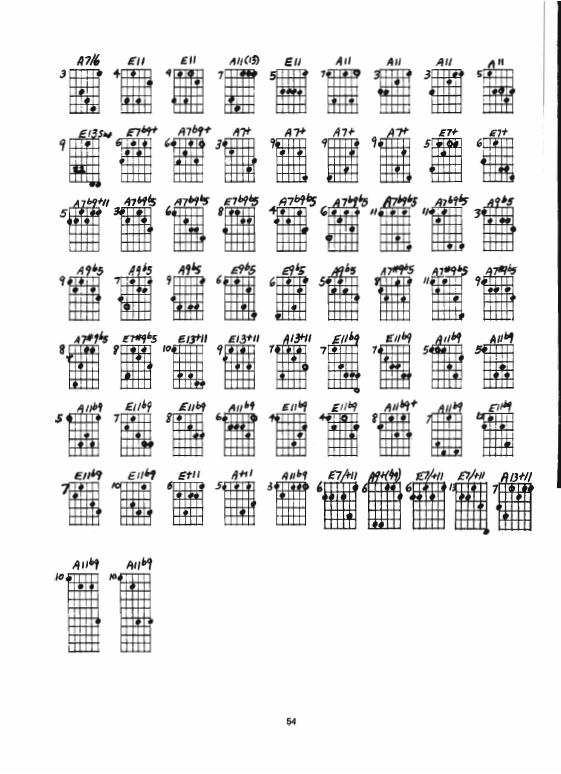
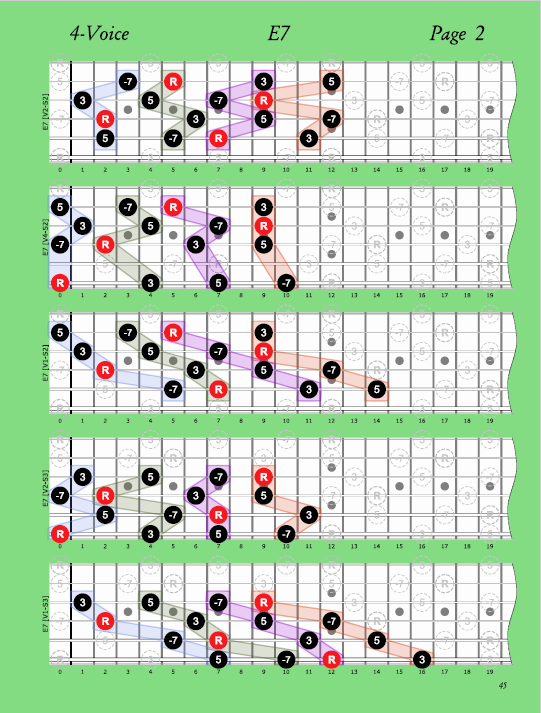
 In the Guitar
Grimoire, before going into the 12 keys there is a closeup view of the open
chord fingering, the moveable chord fingering and the intervals of the
notes. Adam Kadmon's book doesn't have the note names under the strings,
however there is staff notation under each chord for those than can read
it. In constrast The Picture Chord Encyclopedia incorporates note names and
staff notation wonderfully for novice musician and sight readers. If
you only put one chord per diagram, you're able to add notes and intervals
next to each string, however efficient use of space is somewhat reduced. In
theory you could add in ghost note markers for root notes and other
intervals in a lighter colour to increase the usefullness of non-fingered
area.
In the Guitar
Grimoire, before going into the 12 keys there is a closeup view of the open
chord fingering, the moveable chord fingering and the intervals of the
notes. Adam Kadmon's book doesn't have the note names under the strings,
however there is staff notation under each chord for those than can read
it. In constrast The Picture Chord Encyclopedia incorporates note names and
staff notation wonderfully for novice musician and sight readers. If
you only put one chord per diagram, you're able to add notes and intervals
next to each string, however efficient use of space is somewhat reduced. In
theory you could add in ghost note markers for root notes and other
intervals in a lighter colour to increase the usefullness of non-fingered
area.